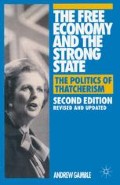Abstract
The Conservatives’ victory in 1979 was decisive but not overwhelming. The party’s share of the vote recovered from its low point in 1974 to reach 43.9 per cent. The Conservatives won 339 seats, a majority over all other parties of 43. A Conservative victory had seemed probable after the collapse of the authority of the government during the IMF negotiations at the end of 1976 and the subsequent loss of its parliamentary majority. Labour had trailed the Conservatives by as much as twenty-five points in the opinion polls in some months between the autumn of 1976 and the summer of 1977. The party had suffered some major by-election losses in this period,1 as well as enormous losses in local government seats.
Our country’s relative decline is not inevitable. We in the Conservative Party think we can reverse it. We want to work with the grain of human nature, helping people to help themselves…. The Conservative Government’s first job will be to rebuild our economy and reunite a divided and disillusioned people.
Conservative Election Manifesto, 1979
Preview
Unable to display preview. Download preview PDF.
Notes and references
See Richard Rose, Do Parties Make a Difference? (London: Macmillan, 1984).
See William Keegan, Mrs. Thatcher’s Economic Experiment; Colin Thain, ‘The Medium Term Financial Strategy’, paper presented to the Political Studies Association Conference April 1985; and
Granarne Thompson, The Conservatives’Economic Policy (London: Groom Helm, 1986) ch. 2.
For contrasting assessments of the 1981 budget see Keegan, Mrs. Thatcher’s Economic Experiment, and
Alan Walters, Britain’s Economic Renaissance (Oxford: Clarendon Press, 1986). Patrick Cosgrave judged it to be the ‘true strategic beginning of the introduction of Thatcherism into government’.
Prior’s caution over trade-union reform and the conflict this created is described by Patrick Cosgrave in Thatcher: The First Term (London: Bodley Head, 1985).
See John Burton, The Job Support Machine (London: CPS, 1979) and
Jock Bruce-Gardyne, Mrs. Thatcher’s First Administration (London: Macmillan, 1984).
See Ian Bradley, Breaking the Mould (Oxford: Martin Robertson, 1981);
D. Kogan and M. Kogan, The Battle for the Labour Party (London: Fontana, 1982); and
Patrick Seyd, The Rise and Fall of the Labour Left (London: Macmillan, 1987).
The internal splits in the cabinet are detailed by Patrick Cosgrave, Thatcher: The First Term; Peter Riddell, The Thatcher Government (Oxford: Basil Blackwell, 1985);
Martin Holmes, The First Thatcher Government 1979–1983 (London: Wheatsheaf, 1985); and
Dennis Kavanagh, Thatcherism and British Politics (Oxford: Clarendon Press, 1987);
Ian Gilmour, Dancing with Dogma (London: Simon and Schuster, 1992). There is also rich additional information emerging from the biographies of ministers such as James Prior and Nigel Lawson plus, of course, Margaret Thatcher’s The Downing Street Years (London: Harper Collins, 1993).
This is argued strongly by Grahame Thompson, The Conservatives’ Economic Policy, William Keegan, Mrs. Thatcher’s Economic Experiment, and Nick Gardner, Decade of Discontent (Oxford: Basil Blackwell, 1987); and
David Smith, The Rise and Fall of Monetarism (Harmondsworth: Penguin, 1986).
For a full account see Cento Veljanovski, Selling the State (London: Weidenfeld, 1987).
See Mike Goldsmith, ‘The Conservatives and Local Government, 1979 and after’, in D. Bell (ed.) The Conservative Government 1979–84 (London: Croom Helm, 1985); and
Patrick Dunleavy and Rod Rhodes, ‘Government beyond Whitehall’, in Henry Drucker et al (eds), Developments in British Politics 2 (London: Macmillan, 1986), ch. 5.
See Huw Beynon, Digging Deeper, and Martin Adeney and John Lloyd The Miners’ Strike: loss without limit (London: RKP, 1986).
See Michael Moran, ‘Industrial Relations’, in Drucker, Developments in British Politics 2, ch. 12, and
Tony Lane, ‘The Tories and the Trade Unions’, in Stuart Hall and Martin Jacques, The Politics of Thatcherism (London: Lawrence and Wishart, 1983), pp. 169–87.
The Labour Research Department estimated that in June 1986 the official government figure of 3 229 400 would have been 3 865 000 on the same basis as the 1979 count. In addition MSC programmes increased the numbers on special training and community schemes from 250 000 in 1979 to 737 000 in 1986; of these an estimated 561 000 would otherwise be registered as unemployed. See Labour Research, A State of Collapse: The UK Economy under the Tories (London, 1987), pp. 24–5.
See Anthony Barnett, ‘Iron Britannia’, New Left Review, 134 (1982), pp. 5–96; and Hall and Jacques, The Politics of Thatcherism, Part III (chapters by Eric Hobsbawm, Robert Gray and Tom Nairn).
See Peter Jenkins, Mrs. Thatcher’s Revolution (London: Jonathan Cape, 1987), ch. 9.
See Peter Hennessy, Cabinet (Oxford: Basil Blackwell, 1986), ch. 3.
See Paul Whiteley, ‘Economic Policy’, in Dunleavy et al. (eds), Developments in British Politics 3 (London: Macmillan, 1990).
David Baker, Andrew Gamble, and Steve Ludlam, ‘1846…1906…1996? Conservative Splits and European Integration’, Political Quarterly, 46:4(1993).
Michael Spicer, A Treaty Too Far (London: Fourth Estate, 1992).
The best account of the Thatcher Years and her downfall is Hugo Young, One of Us (London: Macmillan, 1991).
Keith Dowding, ‘Government at the Centre’, in Dunleavy et al. (eds), Developments in British Politics 4 (London: Macmillan, 1993).
Geoff Whitty, The Politics of the 1988 Education Reform Act’, and Albert Weale, ‘Social Policy’, in Dunleavy et al. (eds), Developments in British Politics 3 (London: Macmillan, 1990).
Gerry Stoker, ‘Government Beyond Whitehall’, in Dunleavy et al. (eds), Development in British Politics 3 (London: Macmillan, 1990).
Copyright information
© 1994 Andrew Gamble
About this chapter
Cite this chapter
Gamble, A. (1994). The Thatcher government, 1979–90. In: The Free Economy and the Strong State. Palgrave, London. https://doi.org/10.1007/978-1-349-23387-8_5
Download citation
DOI: https://doi.org/10.1007/978-1-349-23387-8_5
Publisher Name: Palgrave, London
Print ISBN: 978-0-333-59333-2
Online ISBN: 978-1-349-23387-8
eBook Packages: Palgrave Political & Intern. Studies CollectionPolitical Science and International Studies (R0)

